Tarantula Nebula
The Tarantula Nebula (also known as 30 Doradus) is an H II region in the Large Magellanic Cloud (LMC), from the solar system's perspective forming its south-east corner.
| Emission nebula | |
|---|---|
| H II region | |
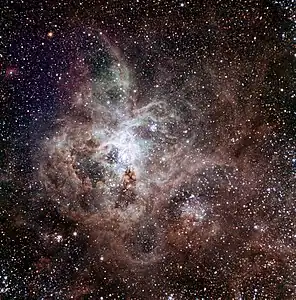 The Tarantula Nebula, first light image of the TRAPPIST national telescope at La Silla Observatory Credit: TRAPPIST/E. Jehin/ESO | |
| Observation data: J2000 epoch | |
| Right ascension | 05h 38m 38s[1] |
| Declination | −69° 05.7′[1] |
| Distance | 160 ± 10 k ly (49 ± 3[2][3] k pc) |
| Apparent magnitude (V) | +8[2] |
| Apparent dimensions (V) | 40′ × 25′[2] |
| Constellation | Dorado |
| Physical characteristics | |
| Radius | 931[2][4] ly |
| Notable features | In LMC |
| Designations | NGC 2070,[2] Doradus Nebula,[1] Dor Nebula,[1] 30 Doradus |
Discovery
The Tarantula Nebula was observed by Nicolas-Louis de Lacaille during an expedition to the Cape of Good Hope between 1751 and 1753. He catalogued it as the second of the "Nebulae of the First Class", "Nebulosities not accompanied by any star visible in the telescope of two feet". It was described as a diffuse nebula 20' across.[5]
Johann Bode included the Tarantula in his 1801 Uranographia star atlas and listed it in the accompanying Allgemeine Beschreibung und Nachweisung der Gestirne catalogue as number 30 in the constellation "Xiphias or Dorado". Instead of being given a stellar magnitude, it was noted to be nebulous.[6]
The name Tarantula Nebula arose the mid 20th century from the appearance in deep photographic exposures.[7]
30 Doradus has often been treated as the designation of a star,[8][9] or of the central star cluster NGC 2070,[10] but is now generally treated as referring to the whole nebula area of the Tarantula Nebula.[11][12]
Properties
The Tarantula Nebula has an apparent magnitude of 8. Considering its distance of about 49 kpc[2] (160,000 light-years), this is an extremely luminous non-stellar object. Its luminosity is so great that if it were as close to Earth as the Orion Nebula, the Tarantula Nebula would cast visible shadows.[13] In fact, it is the most active starburst region known in the Local Group of galaxies. It is also one of the largest H II regions in the Local Group with an estimated diameter around 200 to 570 pc,[2][3] and also because of its very large size, it is sometimes described as the largest, although other H II regions such as NGC 604, which is in the Triangulum Galaxy, could be larger.[3] The nebula resides on the leading edge of the LMC where ram pressure stripping, and the compression of the interstellar medium likely resulting from this, is at a maximum.
NGC 2070
30 Doradus has at its centre the star cluster NGC 2070 which includes the compact concentration of stars known as R136[14] that produces most of the energy that makes the nebula visible. The estimated mass of the cluster is 450,000 solar masses, suggesting it will likely become a globular cluster in the future.[15] In addition to NGC 2070, the Tarantula Nebula contains a number of other star clusters including the much older Hodge 301. The most massive stars of Hodge 301 have already exploded in supernovae.[16]
Supernova 1987A
The closest supernova observed since the invention of the telescope,[17] Supernova 1987A, occurred in the outskirts of the Tarantula Nebula.[18] There is a prominent supernova remnant enclosing the open cluster NGC 2060, but the remnants of many other supernovae are difficult to detect in the complex nebulosity.[19]
Image gallery
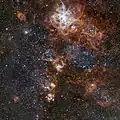 Cosmic landscape of star clusters, glowing gas clouds and the scattered remains of supernova explosions in the Tarantula Nebula[20]
Cosmic landscape of star clusters, glowing gas clouds and the scattered remains of supernova explosions in the Tarantula Nebula[20]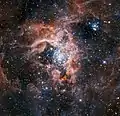 Tarantula Nebula region imaged with HAWK-I with the Adaptive Optics Facility[21]
Tarantula Nebula region imaged with HAWK-I with the Adaptive Optics Facility[21] Hubble's Panoramic View of a Star-Forming Region in the super star cluster called R136
Hubble's Panoramic View of a Star-Forming Region in the super star cluster called R136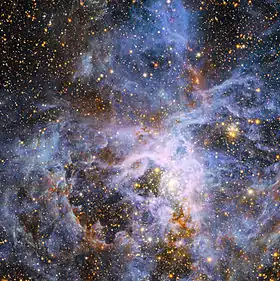
 Close-up of the Tarantula Nebula
Close-up of the Tarantula Nebula.jpg.webp) The young cluster RMC 136a
The young cluster RMC 136a
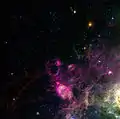 LMC Region near the Tarantula Nebula
LMC Region near the Tarantula Nebula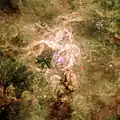 Heart of the Tarantula Nebula: R136 located in the center of the image; Hodge 301 at upper right (Credit: ESO)
Heart of the Tarantula Nebula: R136 located in the center of the image; Hodge 301 at upper right (Credit: ESO) Tarantula Nebula and its surroundings (Credit: ESO)
Tarantula Nebula and its surroundings (Credit: ESO)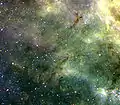 Filaments in The Tarantula Nebula in the LMC (Credit: ESO)
Filaments in The Tarantula Nebula in the LMC (Credit: ESO).jpg.webp) Area around the Tarantula Nebula
Area around the Tarantula Nebula Tarantula Nebula from the Wide-field Infrared Survey Explorer (WISE)
Tarantula Nebula from the Wide-field Infrared Survey Explorer (WISE) Tarantula Nebula image with the Spitzer Space Telescope Jan. 2020
Tarantula Nebula image with the Spitzer Space Telescope Jan. 2020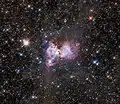 A substructure with the Tarantula Nebula
A substructure with the Tarantula Nebula
References
- "NAME 30 Dor Nebula". SIMBAD. Centre de données astronomiques de Strasbourg. Retrieved 2006-12-22.
- "Results for Tarantula Nebula". SEDS Students for the Exploration and Development of Space. Retrieved 2007-05-08.
30 Doradus .. 49 kpc +- 3 kpc
- Lebouteiller, V.; Bernard-Salas, J.; Brandl, B.; Whelan, D. G.; et al. (June 2008). "Chemical Composition and Mixing in Giant H II Regions: NGC 3603, 30 Doradus, and N66". The Astrophysical Journal. 680 (1): 398–419. arXiv:0710.4549. Bibcode:2008ApJ...680..398L. doi:10.1086/587503. S2CID 16924851.
- distance × sin( diameter_angle / 2 ) = 931 ly. radius
- Jones, K. G. (1969). "The search for the nebulae - VI". Journal of the British Astronomical Association. 79: 213. Bibcode:1969JBAA...79..213J.
- Johann Elert Bode (1801). Allgemeine Beschreibung und Nachweisung der Gestirne: Nebst Verzeichniss der geraden Aufsteigung und Abweichung von 17240 Sternen, Doppelsternen, Nebelflecken und Sternhaufen:(zu dessen Uranographie gehörig). Selbstverl. pp. 1–.
- Feast, M. W. (1961). "A Study of the 30 Doradus Region of the Large Magellanic Cloud". Monthly Notices of the Royal Astronomical Society. 122: 1–16. Bibcode:1961MNRAS.122....1F. doi:10.1093/mnras/122.1.1.
- Pickering, E. C.; Fleming, W. P. (1897). "Large Magellanic Cloud". Astrophysical Journal. 6: 459. Bibcode:1897ApJ.....6..459P. doi:10.1086/140426.
- Burnham, S. W. (1893). "New Double Stars, discovered in 1892, and measures". Monthly Notices of the Royal Astronomical Society. 53: 273. Bibcode:1893MNRAS..53..273B. doi:10.1093/mnras/53.4.273 (inactive 2021-01-11).CS1 maint: DOI inactive as of January 2021 (link)
- Andersen, M.; Zinnecker, H.; Moneti, A.; McCaughrean, M. J.; Brandl, B.; Brandner, W.; Meylan, G.; Hunter, D. (2009). "The Low-Mass Initial Mass Function in the 30 Doradus Starburst Cluster". The Astrophysical Journal. 707 (2): 1347–1360. arXiv:0911.2755. Bibcode:2009ApJ...707.1347A. doi:10.1088/0004-637X/707/2/1347. S2CID 118467387.
- Walborn, N. R. (1984). "The stellar content of 30 Doradus". Structure and Evolution of the Magellanic Clouds. IN: Structure and Evolution of the Magellanic Clouds; Proceedings of the Symposium. 108. pp. 243–253. Bibcode:1984IAUS..108..243W. doi:10.1007/978-94-010-9801-4_59. ISBN 978-90-277-1723-8.
- Aguirre, J. E.; Bezaire, J. J.; Cheng, E. S.; Cottingham, D. A.; Cordone, S. S.; Crawford, T. M.; Fixsen, D. J.; Knox, L.; Meyer, S. S.; Norgaard‐Nielsen, H. U.; Silverberg, R. F.; Timbie, P.; Wilson, G. W. (2003). "The Spectrum of Integrated Millimeter Flux of the Magellanic Clouds and 30 Doradus from Top Hat and DIRBE Data". The Astrophysical Journal. 596 (1): 273–286. arXiv:astro-ph/0306425. Bibcode:2003ApJ...596..273A. doi:10.1086/377601. S2CID 14291665.
- "National Optical Astronomy Observatory Press Release: NEIGHBOR GALAXY CAUGHT STEALING STARS".
- Massey, P; Hunter, D. (January 1998). "Star Formation in R136: A Cluster of O3 Stars Revealed by Hubble Space Telescope Spectroscopy". The Astrophysical Journal. 493 (1): 180. Bibcode:1998ApJ...493..180M. doi:10.1086/305126.
- Bosch, Guillermo; Terlevich, Elena; Terlevich, Roberto (2009). "Gemini/GMOS Search for Massive Binaries in the Ionizing Cluster of 30 Dor". Astronomical Journal. 137 (2): 3437–3441. arXiv:0811.4748. Bibcode:2009AJ....137.3437B. doi:10.1088/0004-6256/137/2/3437. S2CID 17976455.
- Grebel, Eva K.; Chu, You-Hua (2000). "Hubble Space Telescope Photometry of Hodge 301: An "Old" Star Cluster in 30 Doradus". Astronomical Journal. 119 (2): 787–799. arXiv:astro-ph/9910426. Bibcode:2000AJ....119..787G. doi:10.1086/301218. S2CID 118590210.
- "Tarantula Nebula's Cosmic Web a Thing of Beauty". SPACE.com. 2011-03-21. Retrieved 2011-03-26.
- Couper, Heather; Henbest, Nigel (2009). Encyclopedia of Space. DK Publishing. p. 299. ISBN 978-0-7566-5600-3.
- Lazendic, J. S.; Dickel, J. R.; Jones, P. A. (2003). "Supernova Remnant Candidates in the 30 Doradus Nebula". The Astrophysical Journal. 596 (1): 287. Bibcode:2003ApJ...596..287L. doi:10.1086/377630.
- "A Crowded Neighbourhood". www.eso.org. Retrieved 31 May 2018.
- "Sharper Images for VLT Infrared Camera - Adaptive optics facility extended to HAWK-I instrument". www.eso.org. Retrieved 31 January 2018.
External links
| Wikimedia Commons has media related to Tarantula Nebula. |
- Tarantula Nebula on WikiSky: DSS2, SDSS, GALEX, IRAS, Hydrogen α, X-Ray, Astrophoto, Sky Map, Articles and images
- APOD Images: 2003 August 23 & 2010 May 18
- SEDS Data: NGC 2070, The Tarantula Nebula
- Hubble Space Telescope Images of: The Tarantula Nebula
- European Southern Observatory Image of: The Tarantula Nebula
- The Scale of the Universe (Astronomy Picture of the Day 2012 March 12)
- Crowther, Paul. "Tarantula Nebula and Its Huge Stars". Deep Space Videos. Brady Haran.
